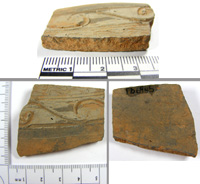Castor ware

Click ^ for larger image.
Roman Castor ware (aka Nene Valley ware) is named after the Roman settlement on the north bank of the Nene, 4 miles west of Peterborough where it was made, probably by immigrant craftsmen, from late 2nd century to the end of the Roman occupation. It was widely distributed throughout Britain and to the Continent by the Roman road system and from wharves on the river Nene.
Castor ware is fine table ware made from white clay. It has a pale fabric with colour coat, ranging from grey to reddish black often with barbotine (raised decoration) of hunting scenes or human figures or scroll and berry design, also grooving, rouletting and sometimes moulding. Some forms imitated samian ware. Course ware forms were also produced. Forms include cups, beakers, jugs, flagons and bottles, bowls, dishes, jars, and boxes complete with lid.
This appears to be a sherd from a large bowl or dish and shows a decorative groove and wavy line pattern and a bold scroll pattern around the circumference, it is pale creamy grey.
Found at Brislington Roman villa site during the development of what is now Winchester Road in December 1899. The villa is contemporary with several others in the region, built about 270 CE as a working farm with workshops until destroyed by fire about the year 370.
Photographs exhibited with kind permission of Bristol Museum and Art Gallery, which has this in its collection (reference number Fb6944).
Material: ceramic
Period: Romano-British
Find spot: Winchester Road, Brislington. ST 616709
Exhibit contributed by Bristol Museum and Art Gallery
Text written by Dawn Witherspoon (2012)
Photographer: Ken Taylor
Acquisition number: 120316b4